Which? What? Pictures and stories of my first ever self-drafted dress! That I finished last year, and never told you about, and finally now am gracing you with it’s presence! It is, basically, proof-positive that I finished Pattern Drafting 101. Taught be me. I was at the head of the graduating class. Which was only me.
Anyway, this is post is dedicated to Bridget. It’s all her fault. No, not really. Really, I could “Thank You” to a million people. Not really. I don’t know a million people. But there is the author of my one-and-only text book (Elizabeth Allemong and her wonderful book European Cut), and my sister who patiently took all my measurements a half-dozen times, and my aunt who introduced me to the world of sewing (but she’d probably die a million deaths if she realized she was responsible for starting me down this path, because for heaven’s sake you’re not supposed to take hobbies so seriously!), and my parents who borned me into this world in the first place—but I’m dedicating this one to Bridget.
Why?
‘Cause otherwise I wouldn’t have finished it, and it doesn’t matter how well you start if you never, ever finish. Oh, I guess I probably would have finished it. Eventually. Sometime. Maybe. But I was getting so sick of this project. I had reached ultimate saturation. I didn’t want to look at it, didn’t want to think about it, didn’t want to work on it. And every time I looked at it, it seemed like it looked worse than it had the time before. And I was, like, 90% of the way there! It just needed finishing up, hemming and boring stuff like that. But instead, it had been tossed into a corner and was just sitting there. Bridget gave me the encouragment, that yes, actually, it’s coming along quite nicely indeed. So finish it.
Also, she kept me company while I cut, sewed, pressed and hemmed 177″ of bias binding. You really, really, really need company when doing something as tedious and mind-numbing as that.
Besides all that, you’d never being seeing this post except for her. She helped me cull through the over 130 photos my (very wonderful) sister took of me wearing the dress (yes, the same sister who took all my measurements!). It’s really no fun looking at over 130 photos of yourself. Then again, maybe she didn’t have fun looking at 130 photos of me, either, but she did it anyway. A true friend (but I’m sure the brownies didn’t hurt, either. . .they were really good brownies).
Anyway, yes. The dress. And me. Brace yourselves!
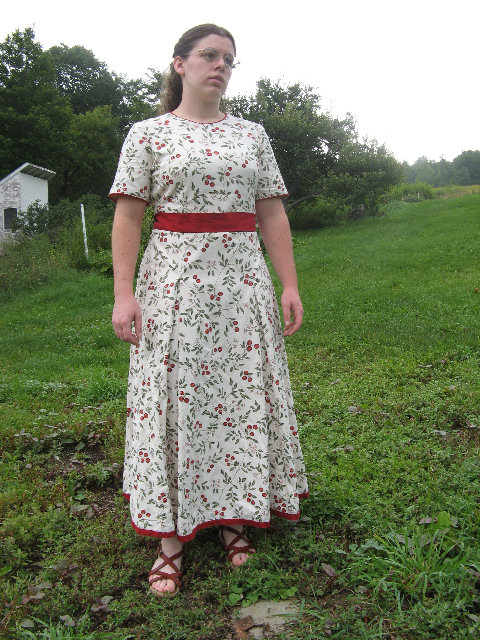
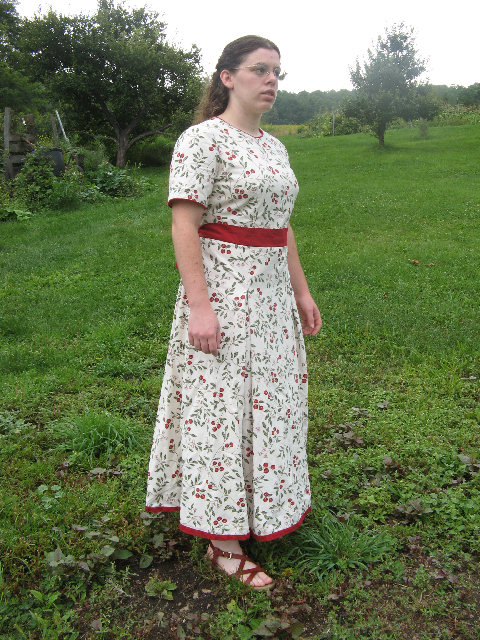


You simply would not believe the tedious hours that went into making this dratted thing. The 177″ of homemade bias binding hem is just the beginning.
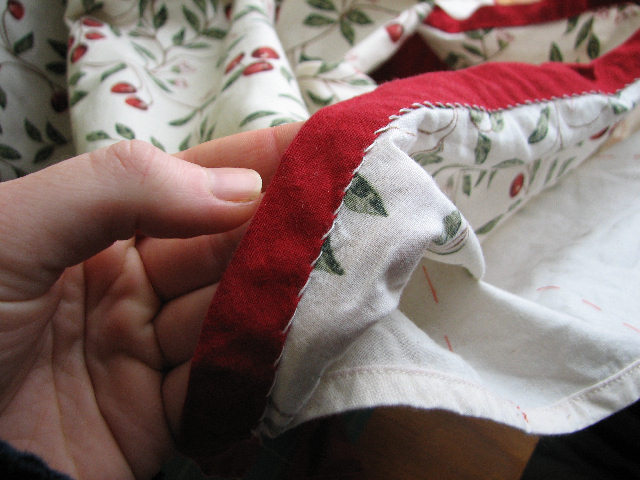
Besides the hem in this picture, you will note a couple of other things. For one thing, the whole dress is underlined. Interlined. Regular old lined. Something. Having bought this fabric way too many years ago when I was young and foolish, I failed to be deterred by the fact that it was rather thin. Very thin. Thin enough it really needed something more to keep it decent. This caused some disappointment to me later on. It may have needed two layers of fabric for opacity’s sake, but those two layers make it much, much warmer. Not so great for wearing during already-quite-warm-enough-thank-you-very-much weather. Everything I have ever read has claimed that building a dress like this will make it less prone to wrinkling, but the whole thing is 100% cotton, so I doubt you’ll see much of a difference on that count.
A second thing you will notice is all the orange thread-tracing lines. Techincally, now that the dress is done, they should be taken out. But that’s fuss and bother, and you can’t see them from the outside, and I’m quite finished working on this. I’m not in the least bit repentant of doing all that thread tracing, though. It was extremely useful for getting the pleats to line up right, and the darts and everything else. It is a time-eater, but if I ever have pieces-that-must-line-up, I would do it again in an instant. It was very reliable, didn’t go away until you wanted it to, and then did go away when you did want it to. It was Precise. I liked it.

This is the inside shoulder; you can see the back shoulder dart. If you look close, you can see my hand stitching securing the muslin underlayer shoulders to each other. I was really doing quite the hybrid. I sewed a lot of the dress treating the muslin and the “fashion fabric” as one—the darts, and most of the seams. But where ever it tickled my fancy, I did it otherwise. The side seams were sewed together, but the inner and outer skirts were hemmed seperately. The muslin was treated as a lining at the neck and sleeve ends, sandwiching the (self-made) piping in between. And here, I sewed the “fashion fabric” shoulder seams seperately from the muslin, and descreetly hand stitched the muslin shoulder seams by hand. It made for a nice smooth finish.
Not that it was all so fine. Most of the time I just zig-zagged the seam allowances. I didn’t have a serger at the time. . .
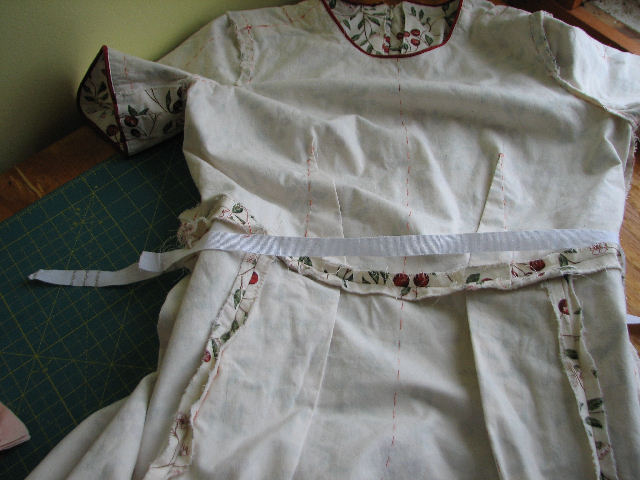
Yes, you do see a waiststay. I was very ambivilant about putting it in. They say it’s supposed to support the weight of the skirt, and keep it from straining the rest of the dress. Having a hem that was 127″, and double layers of fabric, I thought that maybe it was necessary. But it’s rather uncomfortable, and I’m not sure at all that it makes any difference in the least. Especially since this was supposed to be a casual dress. Maybe if I was using fine, delicate fabric, I would be more worried. As it is—-it’s cotton. It’ll survive. Or not. I’m not too worried about it.
I say it was “supposed” to be a casual dress. It was. It was supposed to be the kind of dress you could host a picnic in—unfussy, but nice. The only reason I thought I could get away with such a fitted bodice is because I very cleverly added an ease-pleat in the back of the dress.
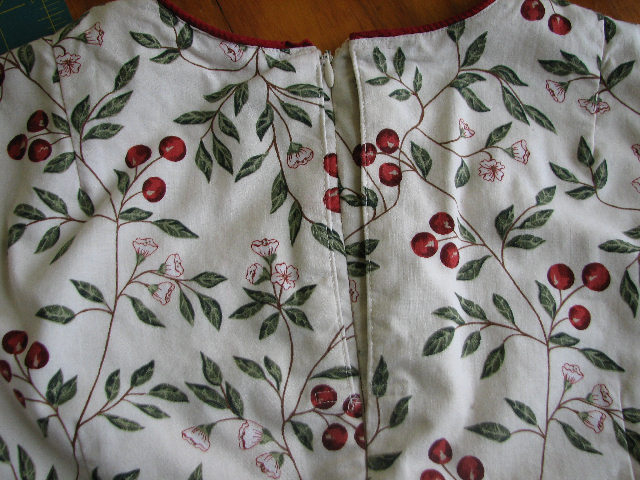
See? Very clever. I even precisely matched the print. Only problem? Sorry, Miss Knucklehead. You need your ease further down than that. As it is, I nearly burst a seam when I try to scoop ice cream, which means that whenever I wear this dress, I feel formal. And by “feel formal” I mean, I feel like I’m good for nothing but standing, prim and proper. Or maybe walking. But not doing anything that involves my reaching with my arms, with eliminates a startling number of activities. Half the time I ignore the “don’t move!” feeling and get on with my life anyway, but it is just not the casual do-anything dress I’d invisioned. I feel like such a failure. Kind of. Not really. The fit is really good, but I’m still pretty annoyed with this dress.

Oh, well. At least I remembered to put in a pocket, and that’s once less annoyance.
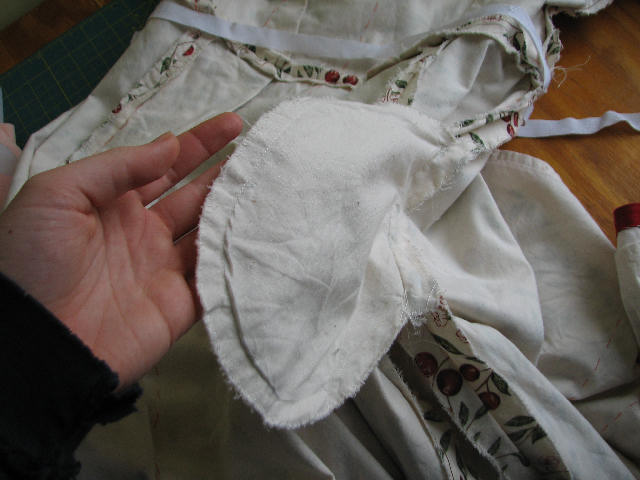
The dratted back ties—they’re dratted because (1) I can’t tie them myself; I never mastered bow-tying behind my back, and (2) I cut it on the bias, which made it very difficult to sew without distorting.
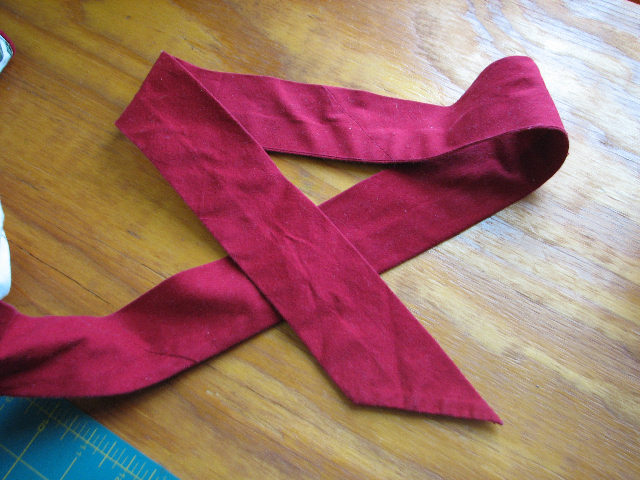
Why did I do that? I don’t know. I think I thought the ties would be more fluid and coopertive when tied. Maybe they are. . .
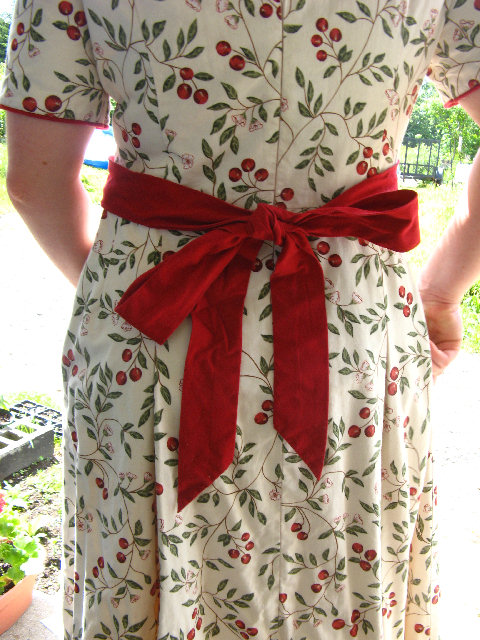
Its loose in the back, but stitched down in the front, along the bottom edge. By hand. After tediously sewing it on by hand, I got it into my head to measure my stitches in their regularity and size. . .

Whoa. 1/16th of an inch, square on, everytime. Freaky. I guess maybe all my hand-quilting is paying off? Somebody go tell the atliers I’m readying for hiring!
I put a lot of silly stress on myself while working on this project. I just felt like it had to be perfect. It was a like a thesis paper, or something. It had to be the proof that I really truly had been learning, did learn. That I could draft to specific measurments and produce quality sewing. As such, how could I ever be fully satisfied with it? Every little mistake seemed like a disaster, completely obscuring the view of the rest of it. Instead of being pleased with how much I had accomplished, I wound up just being disgruntled with every little place where it didn’t seem to me to be perfect. Maybe that’s why, having drafted basic slopers that would enable me to make any dress, skirt or top I could possibly imagine, the only thing I wanted to do next was figure out how to make pants. Instead of feeling like I’d accomplished dress-making, I felt like I couldn’t measure up, and wanted to divert my attention elsewhere. Thankfully, I’ve relaxed (at least a bit), and my pattern drafting has continued.
Besides, in the grand scheme of things, the dress works:

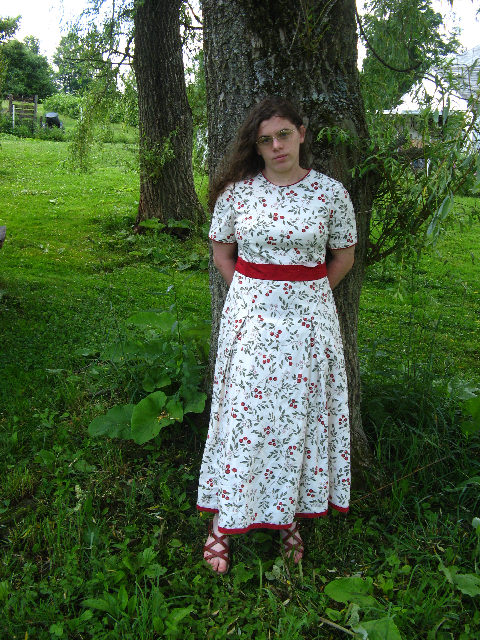



(Yes, you can climb a tree in this dress. If you’re detirmined. Or pig-headed. Take your pick, but I think I have a fair dose of one or the other!)
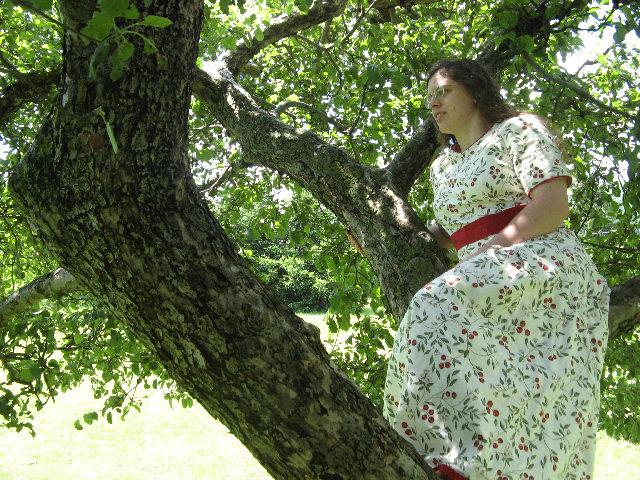




Besides, till this dress, I had only made 4 pieces of clothing for anything other than children. 3 of them were jumpers, and none of them came close to fitting.
I do believe I shall give myself a passing grade.
[Tune in next time, when I discuss my thoughts that went into the design of this dress. I have always been frustated by people who will tell you what they did, without giving any hint as to why they did it. I shall. And it will be fascinating. Sort of. Anyway, I'm out of time for it for now, because I've got to wash dishes, which is just loads of fun.]























